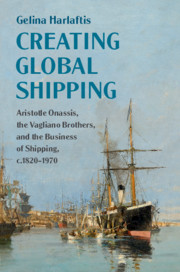 Creating Global Shipping
Creating Global Shipping Book contents
- Creating Global Shipping
- Cambridge Studies in the Emergence of Global Enterprise
- Creating Global Shipping
- Copyright page
- Dedication
- Contents
- Figures
- Maps
- Tables
- Preface
- Acknowledgments
- Abbreviations
- Introduction
- 1 The European and Greek Shipping Firm
- 2 The Vagliano Shipmasters
- 3 An International Trading House from Russia to the United Kingdom, 1850s‒1880s
- 4 The Russian Government v. Mari Vagliano, 1881–1887
- 5 The Vagliano Fleet and Innovation in Ship Management
- 6 Merchant to Shipowner
- 7 The Onassis Fleet, 1946–1975
- 8 The United States Government v. Aristotle Onassis, 1951–1958
- 9 Innovation in Global Shipping: The Onassis Business, 1946–1975
- 10 Diachronic Presence
- Select Bibliography
- Appendices
- Index of Names
- Index of Places
- Index of Terms
9 - Innovation in Global Shipping: The Onassis Business, 1946–1975
Published online by Cambridge University Press: 19 August 2019
- Creating Global Shipping
- Cambridge Studies in the Emergence of Global Enterprise
- Creating Global Shipping
- Copyright page
- Dedication
- Contents
- Figures
- Maps
- Tables
- Preface
- Acknowledgments
- Abbreviations
- Introduction
- 1 The European and Greek Shipping Firm
- 2 The Vagliano Shipmasters
- 3 An International Trading House from Russia to the United Kingdom, 1850s‒1880s
- 4 The Russian Government v. Mari Vagliano, 1881–1887
- 5 The Vagliano Fleet and Innovation in Ship Management
- 6 Merchant to Shipowner
- 7 The Onassis Fleet, 1946–1975
- 8 The United States Government v. Aristotle Onassis, 1951–1958
- 9 Innovation in Global Shipping: The Onassis Business, 1946–1975
- 10 Diachronic Presence
- Select Bibliography
- Appendices
- Index of Names
- Index of Places
- Index of Terms
Summary
Aristotle Onassis was among the first in the shipping business to take advantage of global sourcing, and was instrumental in creating the global shipping business that reinvented the European maritime tradition. He was a prime mover after World War II exclusively in instituting offshore companies, with their flags of convenience, in the rapidly globalizing shipping industry. In the 1950s it was mainly the Greeks that used them; today two thirds of the world fleet flies a flag of convenience. In this way Onassis was a pioneer global entrepreneur. He conducted his business in the 1940s in ways that anticipated modern business practices, not least its globalization. Onassis innovated on four levels. First, he pioneered the modern model of ownership and management of global shipping companies, based on offshore companies, flags of convenience, and multiple holding companies. Second, he was the one to first open the United States financial markets to ship finance. Third, by building tankers in American, European and Asian shipyards, he contributed to the evolution of ship technology and gigantism. And fourth, he reinvented Greek island maritime culture into a corporate shipping culture.
Keywords
- Type
- Chapter
- Information
- Creating Global ShippingAristotle Onassis, the Vagliano Brothers, and the Business of Shipping, c.1820–1970, pp. 231 - 262Publisher: Cambridge University PressPrint publication year: 2019
